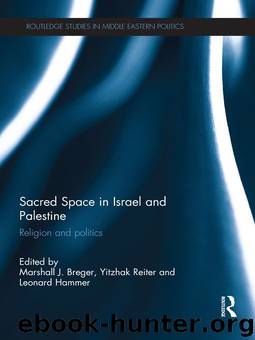Sacred Space in Israel and Palestine: Religion and Politics (Routledge Studies in Middle Eastern Politics) by 2013

Author:2013
Language: eng
Format: epub
Publisher: Taylor and Francis
Published: 2013-06-19T07:00:00+00:00
The qadis and the removal of the waqf
The Ministry of Religious Affairs usually forwarded requests to the qadi to issue a fatwa because the Ministry maintained administrative responsibility over the Shari’a courts. For example, in 1955, the Ramla Municipality sought to construct a road within a Muslim cemetery. The Ministry of Religious Affairs “represented” the municipality before the qadi through an informal exchange of letters.21 In a request from the Ministry of Religious Affairs, the Director of Muslims Department, Dr. Hirshberg, wrote to Qadi Taher Hammad noting that if buried bodies were found during the course of the work, the municipality would bury them at its expense and in accordance with Islamic law.22 In his reply, Hammad wrote to Hirshberg that although he understood that this road had been in existence since the British Mandate period, the area involved was still part of a sacred cemetery and the law of God could not be altered. Thus, he was not willing to permit the asphalting of the road.23 Nonetheless, a week later, Qadi Hammad wrote to Dr Hirshberg stating that he would permit the paving of a road in the Muslim cemetery, without specifying the name of the cemetery.24
It seems that the administrative accountability of the qadis to the Ministry of Religious Affairs during this period25 enabled the Ministry to gain perceived influence over them. The Ministry of Religious Affairs acted in a similar manner with the Mamilla Cemetery in Jerusalem and ‘Abd a-Nabi Cemetery in Jaffa. In 1951, for example, a road was paved in the vicinity of Sheikh Murad Cemetery in Jaffa. An advisory committee appointed by the State uprooted 562 graves in all, thereby allowing the Engineering Department to commence paving the road.26
The technique used for the sale of cemetery land involved the local committee of Trustees. This Committee was appointed by the state to manage local Muslim holy places and was directly accountable to the state. In the case of Sheikh Mu’annis Cemetery (adjacent to Tel Aviv University in Ramat Aviv) located in the Jaffa District, two elderly men came to the qadi27 and “testified” that a section of the cemetery28 had not been used for human burial “for very many years.”29 Accordingly, they asked the qadi to declare the cemetery an area of “general waqf” (non-sacred) “that will bear fruits for the Muslims” (i.e. received funds would serve the Muslims). The two men then argued that since the cemetery had been declared “general waqf property,” someone was needed to manage and realize the site (yastathmiruhu). Upon testifying that the head of the local Committee of Trustees, Sa’id Habbab, was honest and capable of such management, they requested his appointment as the mutawali – the trustee for the cemetery.30 It later emerged that the plot had been purchased by the state and transferred to the Development Authority.31 The remuneration for the cemetery was paid to the Committee of Trustees for the Jaffa waqf32 on 13 March 1969.
The first qadi of Jaffa, Sheikh Taher Hammad, who was a
Download
This site does not store any files on its server. We only index and link to content provided by other sites. Please contact the content providers to delete copyright contents if any and email us, we'll remove relevant links or contents immediately.
Kathy Andrews Collection by Kathy Andrews(11738)
The remains of the day by Kazuo Ishiguro(8832)
Paper Towns by Green John(5093)
Spare by Prince Harry The Duke of Sussex(5078)
Industrial Automation from Scratch: A hands-on guide to using sensors, actuators, PLCs, HMIs, and SCADA to automate industrial processes by Olushola Akande(5001)
The Body: A Guide for Occupants by Bill Bryson(4978)
Machine Learning at Scale with H2O by Gregory Keys | David Whiting(4200)
Be in a Treehouse by Pete Nelson(3956)
Never by Ken Follett(3801)
Harry Potter and the Goblet Of Fire by J.K. Rowling(3776)
Goodbye Paradise(3730)
Into Thin Air by Jon Krakauer(3315)
The Remains of the Day by Kazuo Ishiguro(3296)
The Cellar by Natasha Preston(3265)
Fairy Tale by Stephen King(3229)
The Genius of Japanese Carpentry by Azby Brown(3228)
120 Days of Sodom by Marquis de Sade(3185)
Drawing Shortcuts: Developing Quick Drawing Skills Using Today's Technology by Leggitt Jim(3001)
The Man Who Died Twice by Richard Osman(2998)
